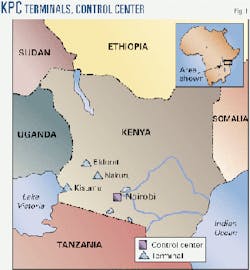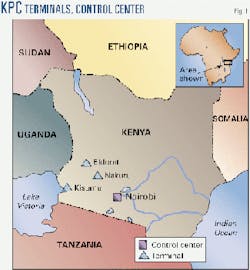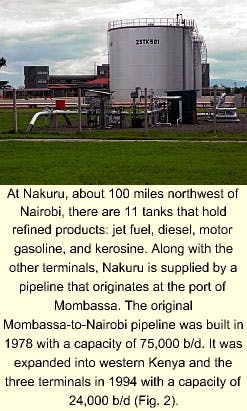Kenya terminals get new automation system
To improve fuel distribution efficiencies, reduce human error, and improve business accounting, Kenya Pipeline Co. (KPC) in December completed installing new terminal-automation systems (TAS) at three of its busiest fuel depots in western Kenya.
KPC installed the FUEL-FACS+ system, marketed by Control Systems Inter national Inc. (CSI), Lenexa, Kan., in depots in Eldoret, Nakuru, and Kisumu, Kenya (Fig. 1).
KPC chose that system in part because of its adaptability to existing hardware that had been part of the previous TAS.
Operation
At each depot, KPC utilizes the new TAS to account for all product receipt, inventory, and dispensing. The system operates as the fuel depot's business database to produce and archive accounting and transportation documentation and to generate standard and custom reports, said CSI in describing the project.
It also monitors tank gauging in real-time, so that operators know the status of product inventory at any given moment. Product dispensed is accounted for and, therefore, can be accurately invoiced.
At the depots, KPC orders are called in before the driver arrives. Upon arrival, the driver first passes through KPC security checks and then registers with the depot's operations personnel.
The KPC operator then accesses the FUEL-FACS+ database to validate the order as well as the supplier's allocation and inventory for the order. Once the order is validated, the system prints a filling-advice notice and the driver is assigned a loading bay.
At the loading bays, the automation system interfaces with Smith Meter Accuload II STD presets, which accumulate all meter flows and monitor loading "permissives"-that is, parameters that ensure safe operation.
The TAS checks the swing arms through the presets, for example, and if the swing arm is not in the correct position, it will not allow the attendant to load.
Or, if a truck is not grounded properly, the preset prevents the operator from loading. This helps prevent hazardous situations, such as static discharge and possible product ignition.
After loading, the TAS automatically generates and prints a bill of lading that KPC uses to generate the supplier's invoice.
Installations
KPC first installed FUEL-FACS+ at Nakuru, its smallest depot, completing the job in November. The system automates the terminal's four top-loading bays that dispense refined products (Fig. 2).
In Eldoret, where the project finished in December, the system is used with four top-loading truck bays, which dispense refined product, and two bottom-loading truck bays, which dispense jet fuel.
The Eldoret depot also uses FUEL-FACS+ to automate one railcar loading point. As in the truck bays, the railcar cannot be loaded until all "permissives" are met.
Operating on the eastern bank of Lake Victoria, Kisumu is the largest KPC depot with six top-loading truck bays, two bottom-loading truck bays, and one railcar loading point. Installation of the TAS was completed in late November.
The new system automatically manages all of the business accounting for the products dispensed there, said CSI. KPC also plans to install the TAS in a marine-loading jetty, now being built in Lake Victoria.
Client workstation
CSI said that FUEL-FACS+ is an open system, using Windows NT, and is supplied standard with multiple third-party interfaces. This resulted in cost savings for KPC because the company did not have to purchase proprietary hardware and software as part of the retrofit.
KPC also installed a TAS client at its Nairobi control center. This client is connected to the TAS server at each site and allows the Nairobi control center to retrieve tank inventory information, daily load information, and daily business transaction data from all three depots.
The client workstation also provides central access to allocations, lockouts, order files, and so forth, stored in the local databases, said CSI. The TAS helps reduce the need for redundant clerical staff at each depot because all the information can be accessed from one central office.
FUEL-FACS+ can manage product movement from pipelines to tanks and from tanks to loading racks, said CSI, while keeping accurate accounting of commingled suppliers and allocations. It can automatically control pumps, valves, and injectors and is scaleable to meet the specific needs of any given depot.


